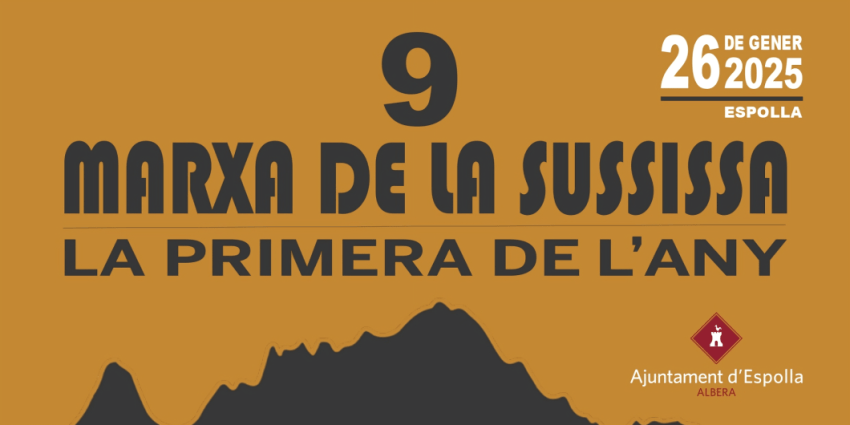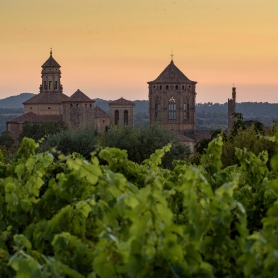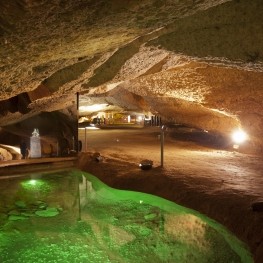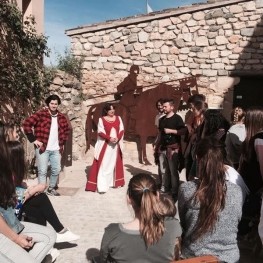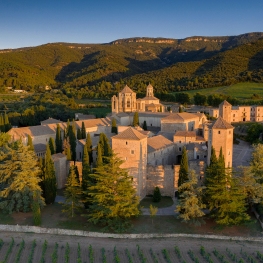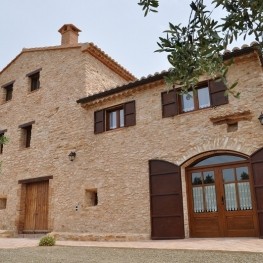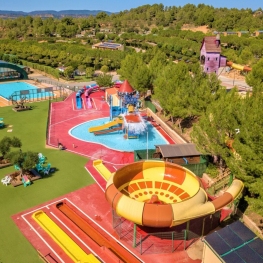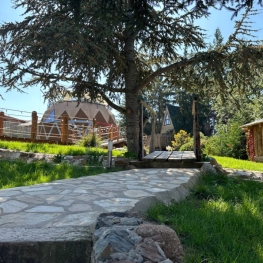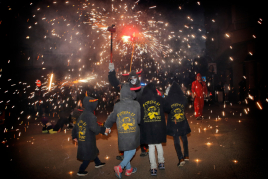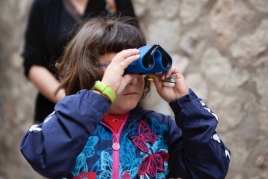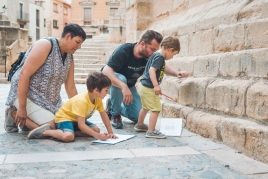Medieval route through Monblanc by Sant Jordi
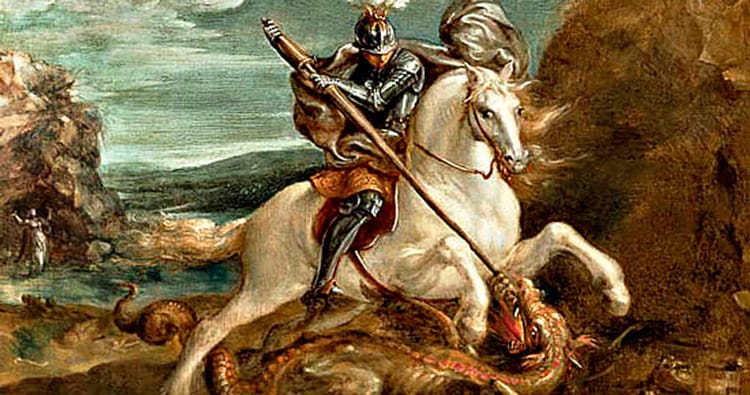
Legend has it that " once upon a time there was a town frightened by a ferocious dragon, which ate all the animals that grazed.
This was not just any dragon, it was the most powerful dragon of all since it could move through the sky, through the land and through the water.
The townspeople were so terrified that they willingly gave oxen and horses to the dragon. Until the day came when the dragon did not have enough and the inhabitants had to raffle to reduce the hunger of the frightful beast.
The king of the people, who was a very good king, added his family to the draw and one unexpected day, the name of the princess came up… "
Does this legend sound familiar to you? Do you want to know what relationship it maintains with the municipality of Montblanc? Well, continue reading the route and you will find answers to these questions.
The legend of Sant Jordi and the relationship with Montblanc
Montblanc, capital of the Conca de Barberà region, is a medieval municipality par excellence.
 It is said that the legend of Sant Jordi took place in this town. In fact, the Catalan costumbrista Joan Amades located the battle between the chivalrous Sant Jordi and the dragon in front of the walls of Montblanc, which are still preserved.
It is said that the legend of Sant Jordi took place in this town. In fact, the Catalan costumbrista Joan Amades located the battle between the chivalrous Sant Jordi and the dragon in front of the walls of Montblanc, which are still preserved.
The reasons why Joan Amades placed the legend of Sant Jordi in Montblanc are due to three reasons: first, the name of Sant Jordi presides over one of the portals of the wall; second, because at that time Montblanc was the seventh largest town in the Catalan principality; and third, why this municipality had the establishment of four Catalan courts.
The medieval week in the municipality of Montblanc
Every year around Sant Jordi day, April 23, the town of Montblanc goes back in time to celebrate medieval week.
 The origin of this festival comes from the concerns of a group of young people motivated "to make a town" in 1981 and in the location of Montblanc, by Joan Amades, as the town where Sant Jordi killed the dragon.
The origin of this festival comes from the concerns of a group of young people motivated "to make a town" in 1981 and in the location of Montblanc, by Joan Amades, as the town where Sant Jordi killed the dragon.
The medieval week is a festival that has been celebrated since 1987, when the first theatrical representation of the legend of Sant Jordi was held in this town in Conca de Barberà.
After this first performance, the Medieval Association of the legend of Sant Jordi was created, which is, mainly, the organizing entity of this act. Although it has the effort and participation of the entire town.
 From the beginning of this festival and throughout the following two weeks, the municipality of Montblanc dresses itself with stately flags and the streets and squares are decked out in remembrance of a first-class medieval city, which is prepared to host the various scheduled events that commemorate the daily events, the acts presided over by the kings and representations of the time; Some of the main events are the medieval market, the representation of the legend of Sant Jordi, the medieval dinner or the minstrels' contest, among others.
From the beginning of this festival and throughout the following two weeks, the municipality of Montblanc dresses itself with stately flags and the streets and squares are decked out in remembrance of a first-class medieval city, which is prepared to host the various scheduled events that commemorate the daily events, the acts presided over by the kings and representations of the time; Some of the main events are the medieval market, the representation of the legend of Sant Jordi, the medieval dinner or the minstrels' contest, among others.
The party, which has been held since the 1980s, has been lengthening until it currently lasts about a week, a fact that leads us to think that the party has been a success and is very popular. So much so that it has even been declared a festival of tourist interest at a national level and has received various awards.
The medieval heritage of Montblanc
 Medieval Week invites us to travel to the Middle Ages, which is between the 5th and 14th centuries.
Medieval Week invites us to travel to the Middle Ages, which is between the 5th and 14th centuries.
In addition to the setting and decoration of the time that is carried out in this municipality to transport us to a medieval city, there are a large number of vestiges corresponding to these dates that make it easier for our imagination to travel through time more easily.
Some of these vestiges that remain in the municipality of Montblanc are the walls; which have a perimeter of 1,500 meters and have four portals, one of which is Sant Jordi; the tower of the zinc cantons (five sides), which is part of the wall; and the Palau Alenyà, also known as the burned house of the Aguilós.
 It should also be added that in the portal and the tower of Sant Jordi, which are still preserved, you can read a commemorative mosaic where it is made known that it was in this place where the knight Sant Jordi killed the dragon, according to legend. Also, it is in this space where the multiple representations that take place during the medieval week are performed.
It should also be added that in the portal and the tower of Sant Jordi, which are still preserved, you can read a commemorative mosaic where it is made known that it was in this place where the knight Sant Jordi killed the dragon, according to legend. Also, it is in this space where the multiple representations that take place during the medieval week are performed.
In addition, we recommend that you attend the guided tour of the " pas de ronda ", a walk through the municipality that will take you through the most emblematic buildings and spaces of the time. This is also organized during the medieval week
The splendor of the medieval town of New Catalonia
The great medieval vestiges that remain in the town of Montblanc make us think that that time was decisive and relevant for the municipality.
 The splendor of the Middle Ages begins to be noticed from the 13th century when the first expansion of the municipality took place, since Montblanc then had two thousand five hundred inhabitants. But it was not until the 14th century that Montblanc became the town that welcomed important monarchs, such as Jaume II and Pere III, who brought prosperity to the town; the walled enclosure is built to protect the town. As well as the raising of great buildings; royal palaces, noble houses... being, therefore, a privileged and remarkable city of the New Catalonia.
The splendor of the Middle Ages begins to be noticed from the 13th century when the first expansion of the municipality took place, since Montblanc then had two thousand five hundred inhabitants. But it was not until the 14th century that Montblanc became the town that welcomed important monarchs, such as Jaume II and Pere III, who brought prosperity to the town; the walled enclosure is built to protect the town. As well as the raising of great buildings; royal palaces, noble houses... being, therefore, a privileged and remarkable city of the New Catalonia.
The popularity was so great that Montblanc became the setting for four Catalan courts where relevant figures from our history passed, such as Ferran de Antequera.
The footprint of the knight Sant Jordi and the day of the book and the rose
 In the eleventh century it is already said that Sant Jordi is the patron saint of the Catalan principality. But it is not until 1456 and 1667 that the festival of Sant Jordi approaches as a festival throughout Catalonia.
In the eleventh century it is already said that Sant Jordi is the patron saint of the Catalan principality. But it is not until 1456 and 1667 that the festival of Sant Jordi approaches as a festival throughout Catalonia.
In addition, Sant Jordi is considered the patron saint of cavalry since, according to Joan Amades, he helped King Pere I of Aragon in his battles during medieval times. King Pere I, as a reason for his gratitude, named him patron of the knights and of the Crown of Aragon.
Sant Jordi is celebrated on April 23 as the death of this saint is commemorated.
This date coincides with International Book Day and evokes the death of Miguel de Cervantes, who also remembers the Catalan writer who died on this day, Josep Pla.
This is the reason why April 23 is also considered the day of the book.
In addition, April 23 has another meaning since we Catalans consider this date as Valentine's Day thanks to the great deed carried out by the knight Sant Jordi in order to save the princess.
Throughout this day red roses are given to women and they give away books.

What to do
Coves de l'Espluga de Francolí
L'Espluga de Francolí (a 5.7 Km)The Espluga de Francolí Caves are a gateway to our country's geological…
Ruta Templera i Hospitalera
L'Espluga de Francolí (a 5.4 Km)Discover the Espluga de Francolí through a tour of the town's old…
Reial Monestir de Santa Maria de Poblet
Vimbodí i Poblet (a 6.7 Km)A magnificent architectural complex located among the most prominent monasteries in Europe.…
Where to eat
Iberik Rocallaura Balneari
Vallbona de les Monges (a 14.8 Km)Iberik Rocallaura Balneari is located on the Cistercian Route, in the municipality…
Where to sleep
Mas Rossell
El Pla de Santa Maria (a 12.6 Km)Mas Rossell is a rural accommodation or farmhouse, located in the municipality…
Iberik Rocallaura Balneari
Vallbona de les Monges (a 14.8 Km)Iberik Rocallaura Balneari is located on the Cistercian Route, in the municipality…
Camping Montblanc Park Capfun
Tarragona (a 1.8 Km)In the interior of the Costa Daurada, the Montblanc Park campsite offers…
Hotel rural - Xalet de Prades
Prades (a 16.5 Km)Immerse yourself in the nature of the Sierra de Montsant Natural Park…


